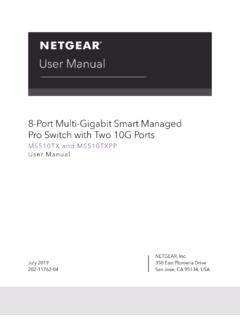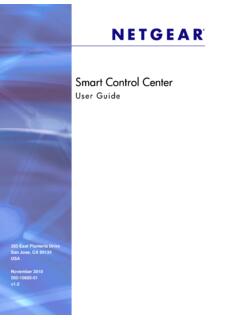Transcription of Not Just Smart: The Importance of Managed Charging
1 Not Just smart : The Importance of Managed Charging Powered by AMPLY Lily Paul, CALSTART Maureen Marshall, CALSTART December 2021 White Paper In partnership with CALSTART | Not Just smart : The Importance of Managed Charging ii Acknowledgments AMPLY Power, a member of CALSTART, contracted with CALSTART to perform an industry assessment on Managed Charging to further understand needs and changes in the electric vehicle fleet market. The authors would like to thank the many individuals and organizations that contributed to this report, including CALSTART staff member Emily Varnell and the following AMPLY Power contributors: Simon Lonsdale: Co-founder, Head of Sales and Strategy Meg Dinga: Product Marketing Manager Jeff Palmer: Partner Manager Rosalyn Jeffries: Sales Operations Manager Heidi Sickler: Director of Policy Lexi Wiley: Vice President of Marketing Any errors are the authors own.
2 Copyright 2021 CALSTART CALSTART @CALSTART CALSTART | Not Just smart : The Importance of Managed Charging iii Table of Contents Acknowledgments .. ii List of Acronyms .. iv Figures and Tables .. v Figures .. v Tables .. vi Executive Summary .. 1 I. What Is Managed Charging ? .. 2 Managed Charging Defined .. 2 Managed Charging Market Trends .. 4 Managed Charging Fleet Based Awareness .. 4 II. Why Is Managed Charging Important? .. 8 Market Growth of Transportation Electrification .. 8 Fleet Electrification .. 8 Technical Assistance for Fleets .. 9 III. Conclusion .. 11 Survey Findings .. 11 References .. 13 Appendix A: Survey Detail .. 15 Background .. 15 Participants ..17 Electrification within Fleets .. 23 Managed Charging .. 38 CALSTART | Not Just smart : The Importance of Managed Charging iv List of Acronyms BEV Battery-Electric Vehicle CaaS Charging -as-a-Service CMS Charge Management Services CORE Clean Off-Road Equipment Voucher Incentive Project EV Electric Vehicle FCEV Fuel Cell Electric Vehicle HTUF High-Efficiency Truck Users Forum HVIP California s Hybrid and Zero-Emission Truck and Bus Voucher Incentive Project kWh Kilowatt Hour NE ZEB Northeast Zero-Emission Bus NYTVIP New York Truck Voucher Incentive Program PHEV Plug-In Hybrid Electric Vehicle SEPA smart Electric Power Alliance TCO Total Cost of Ownership CALSTART | Not Just smart : The Importance of Managed Charging v Figures and Tables Figures Figure 1a-b.
3 Managed Charging Awareness Figure 2a-b. CaaS Awareness Figure 3. Charge Management Familiarity Figure 4a-b. EV Plans Figure A-1. Participants by Response Method Figure A-2. Fleet Domicile Locations Figure A-3. Fleet Type Figure A-4. Survey 1 Fleet Size Figure A-5. Survey 2, Online: Quantity of Each Vehicle Type Figure A-6. Survey 2: Fleet Size Figure A-7a-b. Third-Party Contractors Figure A-8. Survey 1: Interest in Electric Vehicles Figure A-9a-b. EV Ownership Figure A-10a-b. EV Ownership Direct Comparison Figure A-11a-b. EV Plans Figure A-12a-b. EV Plans Direct Comparison Figure A-13. Survey 2: Importance of Obstacles to Adoption of EVs Figure A-14. Survey 2, Online: Weighted Obstacles to EV Adoption Figure A-15. Charging Infrastructure Costs Figure A-16a-b. Charging Infrastructure Cost Estimations When Viewed as a Top Obstacle Figure A-17a-b. Managed Charging Awareness Figure A-18a-b. CaaS Awareness Figure A-19. Charge Management Term Familiarity vi CALSTART | Not Just smart : The Importance of Managed Charging Tables Table 1.
4 Managed Charging Strategy Definitions Table A-1. Fleet Type Definitions Table A-2. Survey 1: Rank of Obstacles to EV Adoption Table A-3. Poll: Greatest Barrier to Fleet s EV Adoption Table A-4. Ranks of Obstacles to EV Adoption Table A-5. Rank of the Importance of Obstacles by State Table A-6. Managed Charging Strategy Definitions 1 CALSTART | Not Just smart : The Importance of Managed Charging Executive Summary Vehicle electrification is increasingly becoming the reality for many fleet operators across the United States. With the transition to electric vehicles (EVs), each fleet operator must add a new dimension to their job Charging the vehicles. Just as there are many ways to charge EVs, there are a variety of methods and solutions to optimize operations through charge management. CALSTART has partnered with AMPLY Power to assess the knowledge of different Managed Charging solutions across the transportation industry to help inform the Charging infrastructure and Managed Charging industries on where knowledge gaps exist.
5 Additionally, this partnership aims to inform fleet operators in various stages of electrification on different options for simplifying their operations and lowering costs while making them more predictable. This knowledge was collected through a series of surveys and polling of fleet providers and industry stakeholders administered by CALSTART from May to November 2021. This research found the following key insights: The number of fleets operating EVs is increasing: 61% of the fleets surveyed in November 2021 are operating EVs, up from 46% from those surveyed in May 2021 a 15% increase in a matter of five months. The number of fleets looking to electrify their vehicles is growing: From May to November 2021, the percentage of fleets planning to deploy EVs within the next year increased from 21% to 54%. The number of fleets and industry stakeholders familiar with Managed Charging and Charging -as-a-service (CaaS) is increasing: The percentage of respondents familiar with Managed Charging increased by 4%.
6 Familiarity with specific approaches to Managed Charging such as automated regular reporting and smart Charging increased by as little as 8% to as much as 38% respectively. Fleet needs vary based not just on vehicle classes, but also on operations and duty cycles: Vehicles not meeting operational needs is one of the key obstacles preventing fleets from moving towards electrification. Even fleets that are electrifying their vehicles continue to struggle with vehicle limitations. The cost for Charging infrastructure is seen as a barrier: Many private fleets must deploy their own Charging infrastructure, and this cost impact is one of the main obstacles of electrification for fleets. This is a challenge that can be directly addressed with various Managed Charging solutions that can lower both upfront and ongoing costs for infrastructure and Charging . As of November 2021, 39% of fleet respondents were not aware of Managed Charging services communicating a great opportunity for further education.
7 2 CALSTART | Not Just smart : The Importance of Managed Charging I. What Is Managed Charging ? Managed Charging Defined When it comes to Charging solutions, hardware is not the only thing to consider Managed Charging is just as critical. Managed Charging is a set of tools that can optimize the operation of Charging infrastructure, improve the total cost of ownership (TCO) analysis for fleet electrification, and enable central or customer control of electric vehicle (EV) Charging to provide vehicle grid integration offerings, including wholesale market services (Blair et al., 2021). Or, as Edward Burgess of Strategen said, Managed Charging is moving when Charging is done to align with grid needs (Trabish, 2020). This definition can include passive Managed Charging , in which incentives, varying electricity costs depending on time of use, or communications influence a user s Charging behaviors or active Managed Charging that directly controls Charging habits or electrical loads via software and/or specialized equipment (Myers, 2019).
8 Managed Charging encompasses smart Charging and software solutions, but also goes beyond these approaches to include Charging -as-a-service (CaaS). Managed Charging is not exclusive to a particular type of Charging and can be used across all Charging levels, though its impact will be most noticeable with higher and faster Charging rates. It is also applicable to fleets of all sizes. Similarly to Charging rates, it has exponentially greater effects as the number of EVs deployed within a fleet increases, but it is still applicable to small fleets in order to smooth operations, decrease costs, and gain insight into electrical refueling operations. Table 1 outlines a few key Managed Charging strategies that were highlighted in a pair of surveys conducted by CALSTART, which will be discussed later in this paper. The strategies below further illustrate what Managed Charging encompasses. 3 CALSTART | Not Just smart : The Importance of Managed Charging Table 1.
9 Managed Charging Strategy Definitions Manag ed Ch arging Strat eg y Definition Manag ed Chargin g Typ e Automated operations Charging operations that do not require manual activation or switching between vehicles Active Automated regular reporting Reports on EV Charging and usage are generated on a regular basis and communicated to relevant parties without requiring user action Active Automatic load management An automated system for monitoring and controlling electrical load voltage, current, power, phase sequence, and network consistency (ABB, b) Active Carbon Program (Low-Carbon Fuel Standard) Participation Programs that grant credits to operators that use fuels below a certain carbon intensity threshold (CARB, ) Passive Demand program and grid services participation Programs to restrict energy usage during peak demand times (Budhiraja, 2019) Passive Dynamic response to changing vehicle assignments Charge management software that automatically shifts Charging power to whichever vehicle needs the most charge based on anticipated energy needs Active Electric tariff optimization Identifying and utilizing the tariff that offers the best value (Utilitas Solutions, ) Passive Fixed pricing EV Charging costs that do not vary depending on time of use Passive Interoperability across heterogenous chargers and vehicle makes and models Ability of different EVs and chargers to seamlessly communicate and function together Active Pay as you use Paying for electric Charging equipment and electricity as it is used Passive Remote diagnostics and troubleshooting Diagnostics and troubleshooting for EV Charging equipment performed remotely through integrated software (ABB, a)
10 Active Scheduled Charging EVs can be plugged into Charging equipment, but Charging does not begin until programmed to do so Active smart Charging When an EV charger has communication technology, such as Wi-Fi, that allows data to be collected and viewed ( Gain, 2021) Active Telematics integration Cloud-based data collection linked with the EV Charging equipment Active 4 CALSTART | Not Just smart : The Importance of Managed Charging Managed Charging Market Trends When planning for electrification, fleets need to place equal priority on their plan for Charging infrastructure and strategy. Though the cost for Charging EVs requires a large capital investment, a major reason fleets are shifting to EVs is that the cost for refueling with electricity is generally low compared to traditional fossil fuels. When the cost of fossil fuels is a fleet s greatest expense, the low cost of electricity can make a huge difference to bottom line operating expenses. However, EV fleet electricity demands can fluctuate greatly, and therefore fleets need to take advantage of off-peak rates or use stored energy solutions to charge EVs during high peak hours to unlock the greatest cost savings through electric refueling.






